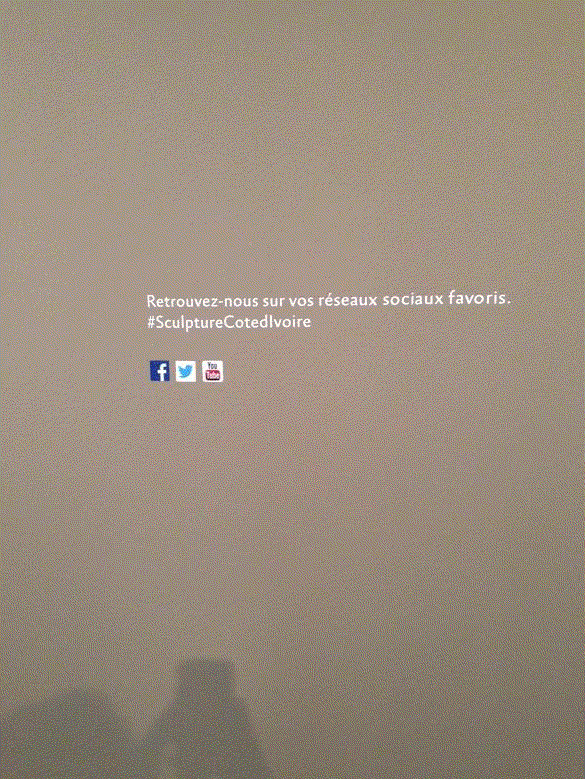
Talking about innovative curatorial practices: I just came across the above image taken at the newly opened Ivory Coast exhibition at the Musée du quai Branly Les Maïtres de la Sculpture de Côte d’Ivoire (info). Visitors are suggested to use the hashtag #sculpturecotedivoire to discover more about the exhibition on their favorite social media. Any avid user of Twitter or Instagram at once knows which hashtag to use when posting pictures of the exhibition online. The success of this idea becomes clear when searching on #sculpturecotedivoire on Twitter here or on Instagram.
I’m happy to notice the Musée du quai Branly is letting people freely photograph the exhibition. I wasn’t allowed to take any pictures at the Sepik show in Berlin and photography isn’t allowed either at the Senufo exhibition at the Cleveland Museum of Art – although they did develop an appfor smartphones. The launch of this app will definitely have increased the usage of smartphones by visitors, but they thus can’t use it at the same time for photographing interesting details or the exhibition installation.
In my experience the gallery assistants never really know why photographing isn’t allowed and what the main objections are*. The availability of postcard reproductions of the highlights at the museum shop is often claimed as an excuse – but those you can’t share online. It is of course a complex discussion. Taking photographs of everything of interest for most young people is a way to experience and enjoy art (and life). As long as it goes together with properly looking at objects (and is done quietly and considerably) I have no problem with that. Museum curators should realize that younger generations ‘consume’ art in a whole new way. Part of the fun now is to share your photos online with friends via social media. Establishing a hashtag, like the Musée du quai Branly did, is a clever way to actively encourage visitors to share images of the exhibition online – and those can only generate additional interest in the art on view.
*There’s of course the widespread belief that flash photography can damage an art object. As this paper shows it’s not more harmful than normal light exposure. Dr Martin Evans explains that the problem is even less of a concern for smartphones, which, no doubt, is how most museum visitors are taking photos (or selfies) these days. He writes:
Many ‘smartphones’ include an illuminator that may be a tiny xenon flash, or a light-emitting diode (LED) that briefly flashes light onto the subject. It is hard to estimate the power of these little illuminators in terms of strict guide numbers, but the consensus is that they can be rated at GN 2 to GN 4. Clearly, flashes from ‘smartphones’ cannot be regarded as a conservation threat in any properly lit gallery.
Anyhow, mobile phones take much better photos without a flash.
UPDATE: Kathryn Gunsch, Teel Curator of African and Oceanic Art at the Museum of Fine Arts in Boston, was kind enough to share a curator’s perspective:
The ban on photography is rarely related to conservation concerns. It is about image rights. Not every lender will allow visitors to photograph the objects on loan to a show. Many museums that allow photography in the permanent collection cannot offer photography in the special exhibitions for this reason. I don’t know of any museum that has tried to allow photography in a special exhibition of some objects but not others -that would likely be an enforcement nightmare!- and so if even one lender declines photography, the whole show can’t be snapped. I hope that helps explain it. I know many of us wish it were otherwise, there’s nothing better than seeing gallery images on pinterest, instagram and elsewhere!
I wonder how many private lenders wouldn’t allow their objects to be photographed, and for what reasons. Maybe an easy solution would be to make the right to be photographed a condition to include an object in an exhibition in the loan contract. A reader also informed me that at the quai Branly’s exhibition visitors are not allowed to photogaph the objects that come from the Musée National de Côte d’Ivoire – there is a pictogram on the info label that states “NO PHOTO”. So it are not just the private lenders – also note that the Sepik exhibition (where photography also was prohibited) only had objects from public collections. Lastly, another reader wrote that photography wasn’t allowed at the previous stop at the Ivory Coast exhibition at the Rietberg Museum. Seems like, for now, each museum has its own approach.
UPDATE2: As Détours des Mondes‘ Martine Belliard-Pinard reports here, photography also isn’t allowed at Milan’s MUDEC.
